-
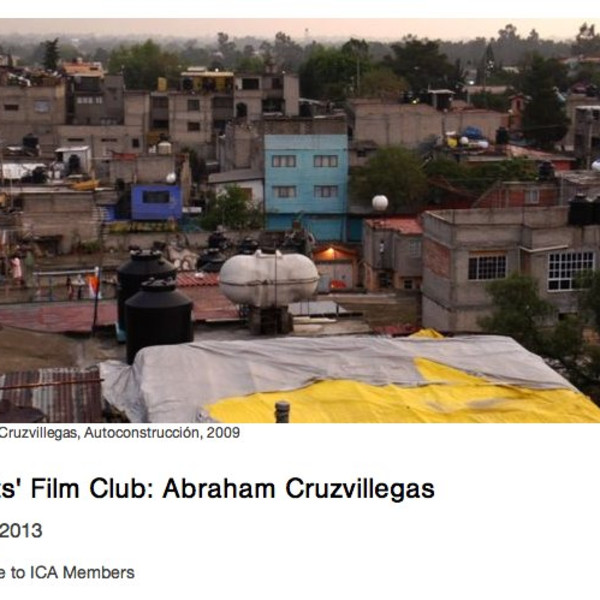
Abraham Cruzvillegas: Artists' Film Club, ICA
Mexican artist Abraham Cruzvillegas makes videos, paintings and sculptures. This screening of Autoconstrucción (2011) draws together his interests in society, class, sex and gender in a video capturing the intimate moments of a spectrum of couples in various locations in a South American city.
Please note that this screening contains adult material.
-
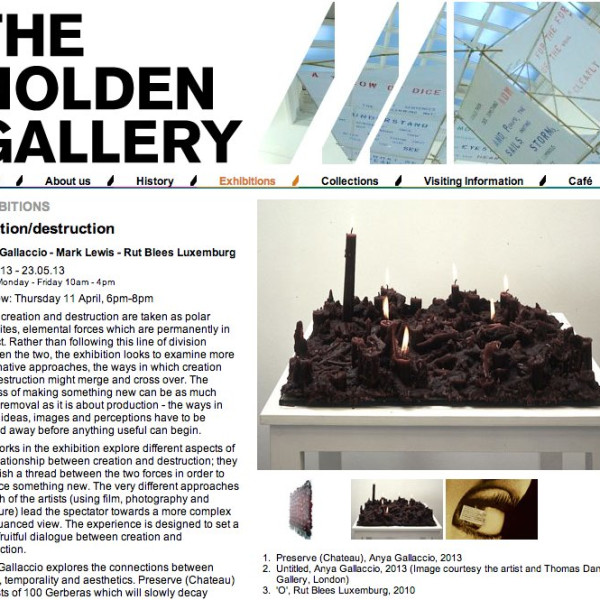
Anya Gallaccio: Creation/destruction, The Holden Gallery, Manchester
Often, creation and destruction are taken as polar opposites, elemental forces which are permanently in conflict. Rather than following this line of division between the two, the exhibition looks to examine more imaginative approaches, the ways in which creation and destruction might merge and cross over. The process of making something new can be as much about removal as it is about production - the ways in which ideas, images and perceptions have to be cleared away before anything useful can begin.
The works in the exhibition explore different aspects of the relationship between creation and destruction; they establish a thread between the two forces in order to produce something new. The very different approaches of each of the artists (using film, photography and sculpture) lead the spectator towards a more complex and nuanced view. The experience is designed to set a more fruitful dialogue between creation and destruction.
Anya Gallaccio explores the connections between decay, temporality and aesthetics. Preserve (Chateau) consists of 100 Gerberas which will slowly decay during the course of the exhibition, a paradox of the familiar creative process. The existence of Red and Green originates from the destruction of an earlier work, Red on Green, an installation of 10,000 roses laid on the gallery floor and left to decay.
Mark Lewis' film North Circular uses a single take to explore the ruins of a modernist office building in London; inside three boys play amidst chaotic remains. This representation of an abandoned building reflects on aspects of time and space and the subject evokes a sense of decay and ruination.
Rut Blees Luxemburg has produced a number of projects each of which investigate the significance of the modern project on the city. The works in the exhibition explore themes of destruction, decay, and erosion through a contrasting range of objects, materials and locations.
-
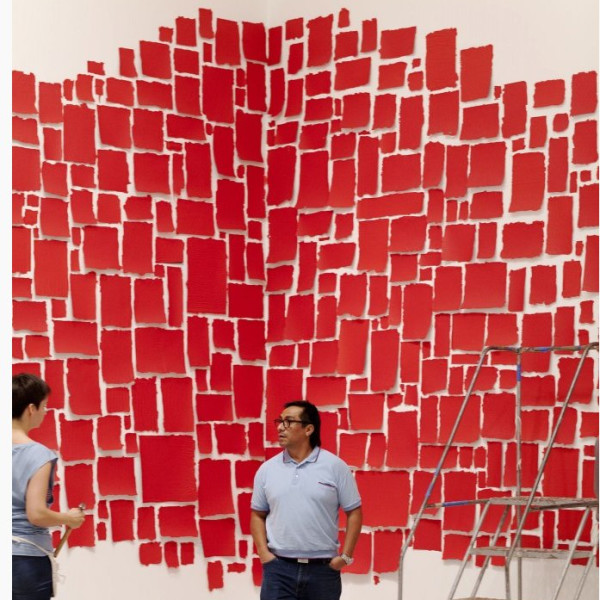
Artists Installing: Abraham Cruzvillegas
A bit of deconstruction preceded the installation process for Abraham Cruzvillegas: The Autoconstrucción Suites: Prior to the Mexico City-based artist's arrival, all the non-load-bearing walls in the Target and Friedman galleries-including the one separating the two spaces-have been removed. It's the first time since the Walker expansion opened in 2005 that the galleries have been opened up into one, creating a massive, 9,500 s.f. exhibition space. Cruzvillegas, who traveled to Minneapolis with his wife and daughter, has been on-site the past two weeks preparing the exhibition for Friday night's preview party and its public opening Saturday. Gene Pittman and Olga A Ivanova of the Walker photography department have been tracking the installation process, capturing the space as it changes and the artist as he works.
-
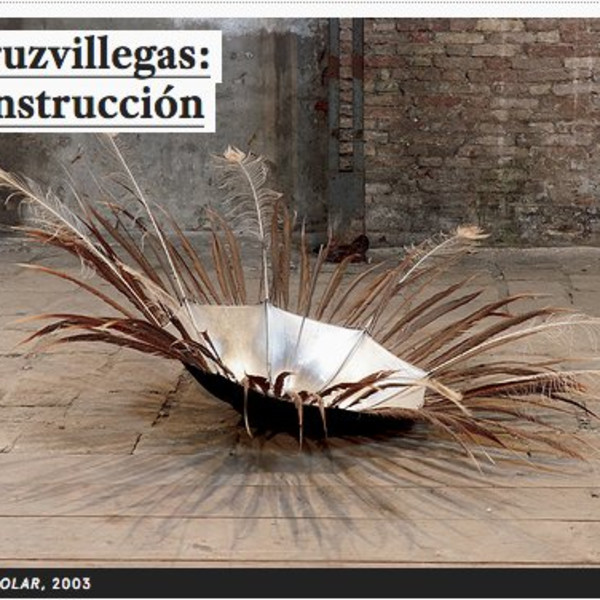
Abraham Cruzvillegas: Walker Art Center, Minneapolis
Minneapolis, January 10, 2013-The Walker Art Center will presentAbraham Cruzvillegas: The Autoconstrucción Suites, the first in-depth contextual exhibition of Abraham Cruzvillegas, one of the most important artists to come out of a burgeoning art scene in Mexico City. Informed by the sociopolitical contexts of Latin America, Cruzvillegas (b. 1968) has garnered much attention for his dynamic assemblage sculptures made of found objects. The exhibition will run from March 23 through September 22, 2013.Since the 1990s, Cruzvillegas has developed a riveting body of work-including sculpture, installation, film/video, and theater-that derives from the social and economic realities of his hometown in Ajusco. While his work has been widely presented in Mexico and Europe, his exposure in the U.S. still remains limited. Organized by Walker Senior Curator for Visual Arts Clara Kim, this mid-career survey will focus on the last 10 years of his practice and will feature individual sculptures and expansive sculptural environments, as well as recent experiments in video, film, and performance. Following the Walker's presentation, the exhibition will embark on an international tour to the Haus der Kunst in Munich in early 2014 and the Jumex Foundation in Mexico City and Museo Amparo in Puebla who will jointly present the exhibition in Mexico in fall 2014.
Interested in what he calls autoconstrucción or "self-construction," Cruzvillegas roots his practice within the urban landscape of his childhood home, where structures are in a constant state of change as materials become available and as necessity dictates. The conceptual framework and ideology of his dynamic sculptural work begins here. While echoing art historical precedents (Duchampian transformation of everyday objects, arte povera's use of impoverished materials, and the uncanny compositions of assemblage), Cruzvillegas employs improvisation and alternate economic systems that privilege craft over art, the handmade over the manufactured, and processes that necessitate "making do" or learned, communal behavior. This point of departure becomes a model for a way of building out of scarcity and a metaphor for the construction of the artist's own identity.
Developed in close collaboration with the artist, the exhibition will include an important body of sculptures first exhibited at the 2003 Venice Biennale, in a section titled Everyday Altered curated by Gabriel Orozco; a series of sculptural installations created during a six-year period of residencies; and more recent experiments that expand his thinking onautoconstrucción through film (developed with a film cooperative), video (in which the artist's parents narrate their own stories in the form of oral history), performance (collaborative musical and action-based theater), and a source material archive room. Shown together for the first time, the exhibition will illustrate Cruzvillegas's contributions, and motivations and influences that inform his thinking, as well as his commitment to social and political realities that shape everyday lives.
-
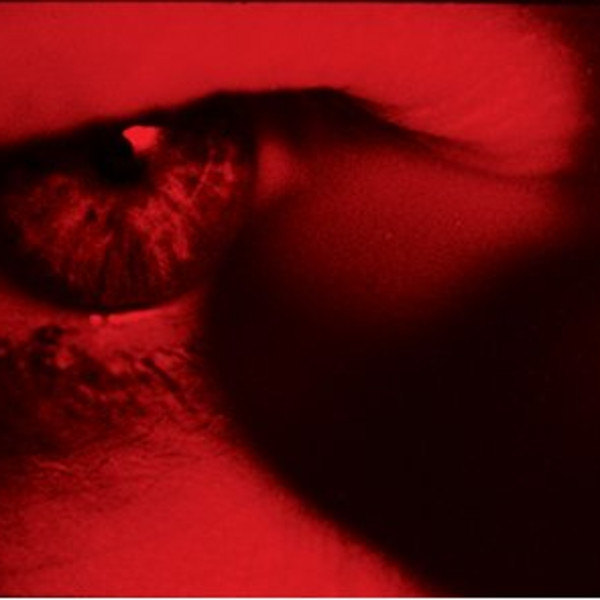
Steve McQueen: Schaulager, Basel
Steve McQueen (born London 1969) is one of the most significant contemporary British artists. The largest exhibition to date of this artist's work will provide a detailed insight into his complex and unusual oeuvre. Installations, photographs and film from every period of his artistic career will be shown.
Steve McQueen's early works are characterised by an experimental approach to cinematic history and the dynamic between black and white, particularly in the aesthetic of silent film, such as French avant garde film and American slapstick. Over the past ten years this aspect of his work has been joined by an exploration of the boundaries between the documentary and the narrative.
In 1999 Steve McQueen was awarded the Turner Prize. In 2008 he won the Caméra d'Or at the Cannes Film Festival with the feature film 'Hunger'. In 2009 he represented the United Kingdom at the Venice Biennale and in 2011 he was invited to enter the Venice Film Festival's competition with his film 'Shame'.
The exhibition will be co-organised by Schaulager and The Art Institute of Chicago. Schaulager will publish a comprehensive catalogue to accompany the exhibition.
-
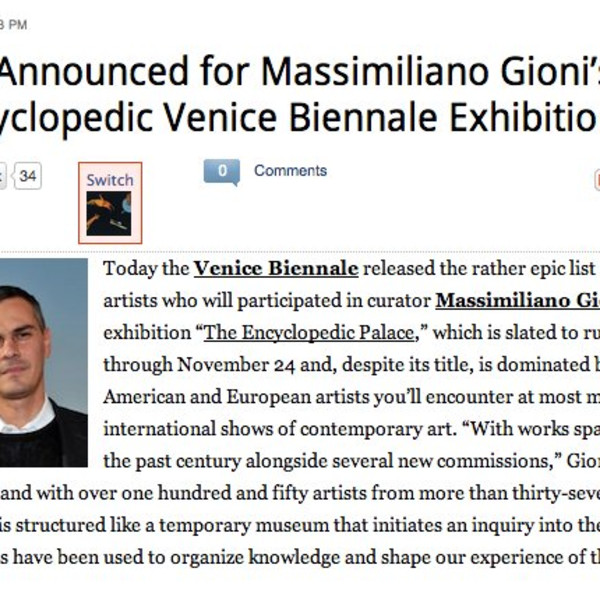
Artists Announced for Massimiliano Gioni’s Not-So-Encyclopedic Venice Biennale Exhibition
Today the Venice Biennale released the rather epic list (see below) of artists who will participated in curator Massimiliano Gioni's exhibition "The Encyclopedic Palace," which is slated to run from June 1 through November 24 and, despite its title, is dominated by the same American and European artists you'll encounter at most major international shows of contemporary art. "With works spanning over the past century alongside several new commissions," Gioni writes in his introduction, "and with over one hundred and fifty artists from more than thirty-seven countries, the exhibition is structured like a temporary museum that initiates an inquiry into the many ways in which images have been used to organize knowledge and shape our experience of the world."
The exhibition's title and theme were inspired by Italian-American artist Marino Auriti, who conceived of an encyclopedic museum of world culture in Washington, D.C. that would be 136 stories tall with a 16 block footprint, and called the "Palazzo Enciclopedico" (or "Encyclopedic Palace"). Though he spent years working on a model for the enormous structure in his home in rural Pennsylvania - and filed a patent application for it with the U.S. Patent office - Auriti's palace, as you may have guessed, was never built.
Gioni sees such "delusions of omniscience, shed light on the constant challenge of reconciling the self with the universe, the subjective with the collective, the specific with the general, the individual with the culture of her time." In our contemporary situation of sensory overload and data deluge, the curator considers "such attempts to structure knowledge into all-inclusive systems seem even more necessary and even more desperate."
The list of participating artists includes a who's-who of contemporary American heavyweights -Nauman, Condo, Sherman, McCarthy, de Maria, Guyton, Serra, Trecartin, and so on - a similarly comprehensive cross-section of major European artists - including Fischli & Weiss,Kjartansson, Sarah Lucas, Steve McQueen, and Sehgal - a select few from other regions - four artists each from Africa and South America, and nine from Asia (so much for being encyclopedic) - and historical artifacts like Haitian Vodou flags, Shaker gift drawings, and anonymous Tantric paintings. As GalleristNY notes, the number of artists in the exhibition who've recently shown at the New Museum - where Gioni is the associate director and a curator - is conspicuous, though not entirely surprising.
The full list is below:
Hilma af Klint
Victor Alimpiev
Ellen Altfest
Pawel AlthamerLevi Fisher Ames
Yuri Ancarani
Carl AndreUri Aran
Yüksel Arslan
Ed AtkinsMarino AuritiEnrico BajMiroslaw BalkaPhyllida Barlow
Morton BartlettGianfranco Baruchello
Hans BellmerNeïl Beloufa
Graphic Works of Southeast Asia and Melanesia, Hugo A. Bernatzik Collection 1932-1937Stefan Bertalan
Rossella BiscottiArthur Bispo do RosárioJohn Bock
Frédéric Bruly Bouabré
Geta Bratescu
KP Brehmer
James Lee ByarsRoger CailloisVarda Caivano
Vlassis CaniarisJames CastleAlice Channer
George CondoAleister Crowley and Frieda HarrisRobert Crumb
Roberto CuoghiEnrico DavidTacita DeanJohn De AndreaThierry De Cordier
Jos De Gruyter and Harald ThysWalter De MariaSimon DennyTrisha DonnellyJimmie DurhamHarun FarockiPeter Fischli & David WeissLinda Fregni NaglerPeter FritzAurélien FromentPhyllis GalemboNorbert GhisolandYervant Gianikian and Angela Ricci LucchiDomenico GnoliRobert GoberTamar Guimarães and Kasper AkhøjGuo FengyiJoão Maria Gusmão and Pedro PaivaWade GuytonHaitian Vodou FlagsDuane HansonSharon HayesCamille HenrotDaniel HesidenceRoger HiornsChanna HorwitzJessica Jackson HutchinsRené IchéHans JosephsohnKan XuanBouchra KhaliliRagnar KjartanssonEva KotátkováEvgenij KozlovEmma KunzMaria LassnigMark LeckeyAugustin LesageLin XueHerbert ListJosé Antonio Suárez LondoñoSarah LucasHelen MartenPaul McCarthySteve McQueenPrabhavathi MeppayilMarisa MerzPierre MolinierMatthew MonahanLaurent MontaronMelvin MotiMatt MullicanRon NagleBruce NaumanAlbert OehlenShinro OhtakeJ.D. 'Okhai OjeikereHenrik OlesenJohn OutterbridgePaño DrawingsMarco PaoliniDiego PerroneWalter PichlerOtto PieneEliot PorterImran QureshiCarol RamaCharles RayJames RichardsAchilles G. RizzoliPamela RosenkranzDieter RothViviane SassenShinichi SawadaHans SchärerKarl SchenkerMichael SchmidtJean-Frédéric SchnyderFriedrich Schröder-SonnensternTino SehgalRichard SerraShaker Gift DrawingsJim Shaw
Cindy ShermanLaurie Simmons and Allan McCollumDrossos P. SkyllasHarry SmithXul SolarChristiana SoulouEduard SpelteriniRudolf SteinerHito SteyerlPapa Ibra TallDorothea TanningAnonymous Tantric PaintingsRyan TrecartinRosemarie Trockel
Andra UrsutaPatrick Van CaeckenberghStan VanDerBeekErik van LieshoutDanh Vo
Eugene Von BruenchenheinGünter WeselerJack WhittenCathy Wilkes
Christopher Williams
Lynette Yiadom-BoakyeKohei Yoshiyuki
Sergey ZarvaAnna ZemánkováJakub Julian ZiólkowskiArtur Zmijewski"The Encyclopedic Palace" runs June 1-November 24 at the Giardini and the Arsenale.
-
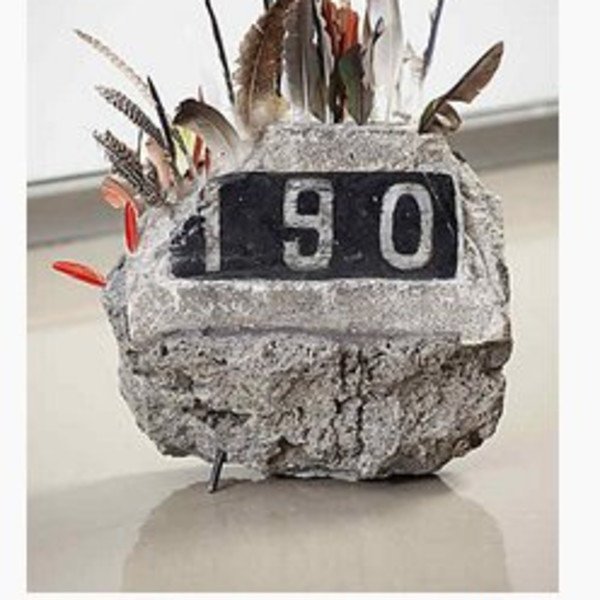
Prime Matter: Abraham Cruzvillegas on “Autoconstrucción”
"I use 'dead' things, or materials people think of as garbage," says Abraham Cruzvillegas, "and give them a new use by revealing instead of hiding their nature." Over the past 10 years, the Mexico City-based artist has become recognized as a key figure among his generation, bringing a fresh conceptual strategy to the use of found materials and improvisational processes. The result is a riveting body of work that he calls autoconstrucción, or "self-construction," made from found objects to which he's given new life while working in urban and rural environments in Mexico City; New York; Paris and Saché, France; Glasgow, London, and Oxford, UK; and Gwangju, South Korea.
Each of these commonplace components contributes its own striking character and seemingly precarious form to a sculpture or installation. Here, the artist sheds light on his practice and how it underpins his artistic vision while also serving as a metaphor for the construction of his own identity. Abraham Cruzvillegas: The Autoconstrucción Suites is the first major exhibition to focus on this multifaceted project.
Origins
The autoconstrucción concept comes from a building technique that is led by specific needs of a family and by the lack of funds to pay for constructing an entire house at once. People build their own homes slowly and sporadically, as they can, with limited money, with the collaboration of all family members and the solidarity of neighbors, relatives, and friends. Houses show the autoconstrucción process in their layers, through which it is possible to experience their transformations, modifications, cancellations, and destructions; they evolve according to changes in the lives of their residents.
Aesthetic decisions are intertwined with the ability of the builders to use anything available or at hand, depending on place, circumstance, or chance. The combinations of materials and hybrid construction strategies are very rich and diverse. Autoconstrucción is not a weekend hobby; it's not bricolage or DIY culture-it's a consequence of unfair wealth distribution. As opposed to massive building projects, it points to an autonomous and independent architecture that is far from any planning or draft: it's improvised.
While this kind of building happens all around the world, as in Brazilian favelas or South African shanty towns, in my personal experience I lived with autoconstrucción during the first half of my life, witnessing the evolution of my parent's house in Ajusco, south of Mexico City. This is a land of volcanic rock that was settled starting in the early 1960s by immigrants from the countryside looking for a better life in the big city.
Bit by bit, they started building houses with lava stones and recycled materials gathered in other neighborhoods. For years there was no water and in general, no services at all. Fighting for this land to become property, as well for streets, access to electricity, etc., became an everyday activity. Women became leaders in those movements, along with young guys and children, while men were working, many of them as construction workers in so-called modern Mexico.
When I Started to Use It
I have appropriated the term "autoconstrucción" as a name for all my work since 2007, when I improvised a whole exhibition in New York, working only with materials found around a gallery. I was attempting to reproduce the dynamics of autoconstrucción-rather than represent the results, I wanted to activate the process. I started working with the idea as a personal fact (and not as a chosen subject matter) that had been underlying my work since 1999, when I took many pictures of the houses in my neighborhood, the volcanic rock there, and details of my parents' house.
Then I wrote the story of my own experience, what I witnessed all those years, without nostalgia- just facts. This text became a book accompanied by many images, including some lent by neighbors, captured during the early years of the autoconstrucción. It was published in Glasgow, where I was invited by Francis McKee to do a project at theCentre for Contemporary Art. At this point I've made autoconstrucciónsculptures, drawings, paintings, videos, a theatrical play, and a film. Maybe it's time to move to "autodestrucción."
What It Means
As a structure in which everything is possible, autoconstrucción can take shape in infinite and diverse ways. It is a way of thinking more than a method or a technique; it's a way of life. Improvisation and testing all kinds of combinations according to specific needs (like expressing oneself) are rules of autoconstrucción, rules that provide absolute freedom. For me, autoconstrucción is the most authentic type of creativity, because it blooms in the most adverse circumstances. It's pure ingenuity and will, fueled by hermeneutics, use, function and/or contradiction. It is transparency, simplicity, and change.
System of Production/Ideological Framework
It's easy to perceive the economic and cultural origins of the materials composing an autoconstrucción; and this evidence produces complex readings for both viewers and inhabitants. The will to construct is more important than the aesthetic or economic value of any or all of the materials that might be used. When an object is discarded by a person, it's valueless; for autoconstrucción, it could be seen as prime matter.Autoconstrucción does not deal with garbage, but with prime matter.
Recycling has only recently become a widespread practice, but for centuries in so-called underdeveloped countries, scavenging and harvesting used materials and objects has been an activity. Pepenadores in Mexico pick cardboard, metals, discarded furniture, cans, bottles, paper, and other materials from the garbage in order to give them a new life. They collect, classify, accumulate, resell, and transform these goods. Then a new cycle starts. When I make an artwork with found objects or materials-i.e., aluminum, wood, a forgotten bicycle, my own hair, shark jaws, a cowbell, teeth, a chair, wax, coins, plastic, or sheep dung-theyretain their original qualities and defects.
Even if the piece is later dismantled, its fragments remain as they were before they were incorporated: there is no alchemical transformation, there is no trick or magic. Transformation occurs only in the viewer's mind. And in my hands, of course. So, a stone is a stone before, during, and after the art/architecture approach; it does not represent anything else but a stone being a stone as a stone. When the same stone is removed from the pavement to be thrown over a police barricade, or through the window of a government office, it will still be a stone. But a happy one.
Autoconstrucción meant for me, for many years before making art, a constant struggle with authority, and not only because of growing up in a challenging situation, learning to deal with scarcity, solidarity, roughness, and resistance to the environment, to the local governors, to self-indulgence. Now it's more an ideological consequence in which all my acts involve my genealogy and my future as trying to arrive to a certain degree of consciousness based in all that I've mentioned above.Autoconstrucción is not biographical or anecdotal, is not narrative, it's not thematic or communicative. It is the very expression of survival and work. It's also humorous, ironic, paradoxical, and delirious.
-
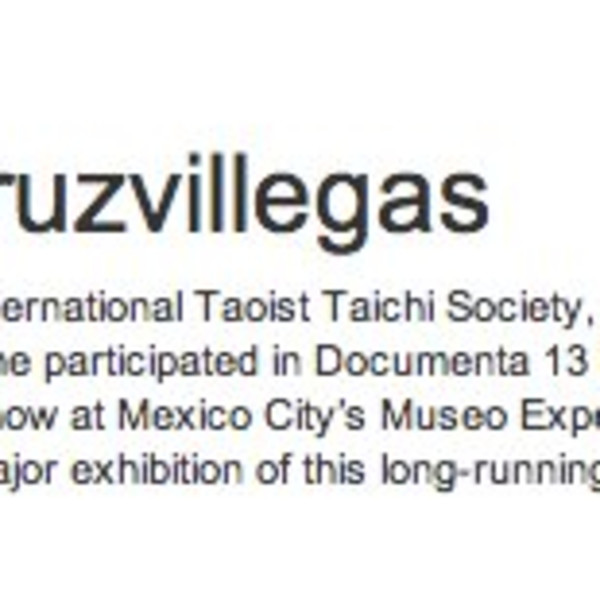
Abraham Cruzvillegas: Top Ten
An artist and member of the International Taoist Taichi Society, Abraham Cruzvillegas lives and works in Mexico City. In the past year, he participated in Documenta 13 in Kassel, won the Fifth Yanghyun Prize in Seoul, and presented a solo show at Mexico City’s Museo Experimental El Eco. On March 23, he opens “TheAutoconstrucción Suites,” a major exhibition of this long-running project at the Walker Art Center in Minneapolis.
-
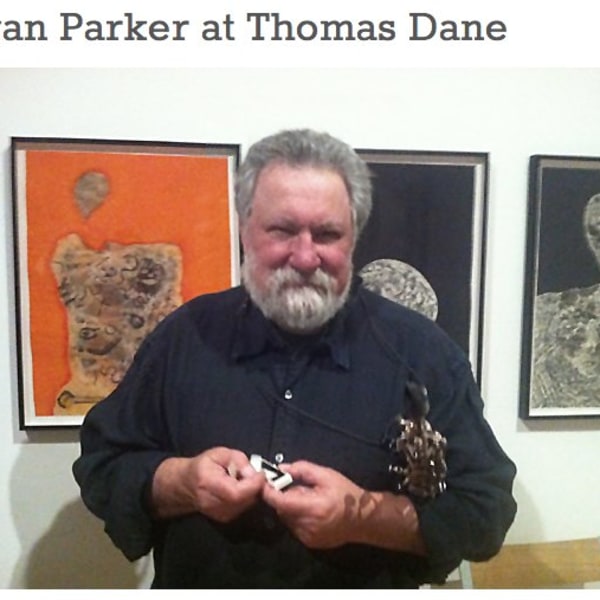
Evan Parker at Thomas Dane Gallery
Events in galleries can sometimes combine the best of two worlds, and in the case of the recent solo performance by Evan Parker at the Thomas Dane Gallery, those two worlds are art and music. The Gallery put the evening on quietly, in a relatively small space, and it was completely amazing.
Anyone who knows Parker's style will be fully aware that music is a flexible term and his circular-breathing, ten- to fifteen-minute bursts of densely-layered, amelodic, soprano saxophone with continual fluttering and super-rapid fingering is something that has to be heard to be properly appreciated.
To that end, I recommend listening to this for an introduction (that was then and this is now, but it gets the vibe across) - and you'll get an idea why, over a forty-year career, Evan Parker has carved out an untouchable reputation for ploughing his own artistic furrow.
The performance accompanied Thomas Dane's excellent Dominick Di Meo exhibition Limp Voyeur In a Humid Landscape - the first overview of 'self-acknowledged recluse' Di Meo outside the US and a UK introduction to a man who, in Chicago in the '50s, was part of the 'Monster Roster' - reason enough for an examination of his work.
Dominick Di Meo Limp Voyeur In a Humid Landscape is on at the Thomas Dane Gallery until April 13.
www.thomasdane.com -
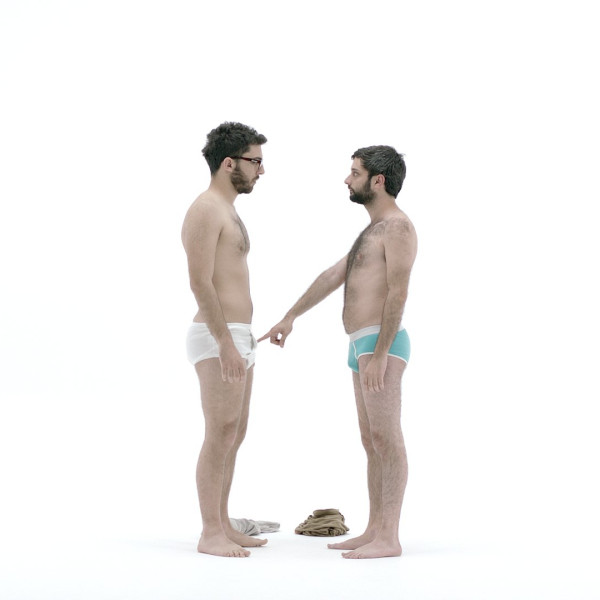
Akram Zaatari and Jean-Luc Moulène, 'Ici, Ailleurs (Here, Elsewhere)': Friche de la Belle de Mai, Marseille
Ici, ailleurs Exposition inaugurale de la Tour-Panorama et l'année Capitale
Pour l'inauguration de ce nouvel espace, une ambitieuse exposition invite des artistes contemporains des deux rives. Si toute œuvre s'inscrit dans un contexte originel et une histoire singulière, le voyage et le nomadisme qui caractérisent l'artiste contemporain constituent une expérience existentielle, qui devient le lieu même de la création. À l'ère de la globalisation, au contact de la diversité du monde et des cultures, l'identité de chacun se trouve sans cesse remaniée. Une quarantaine d'artistes issus des pays du pourtour de la Méditerranée ont été choisis sur leur aptitude à nous repenser en êtres aux identités plurielles, en perpétuel devenir, et sur leur capacité à investir le réel en une réflexion critique. Ils appartiennent pour la majorité d'entre eux à la génération née dans les années 1960-1970 et jouissent d'une reconnaissance sur la scène internationale. Parmi les œuvres exposées, dont un grand nombre de propositions inédites conçues pour l'exposition, quelques-unes traitent du paysage méditerranéen. Elles sont nombreuses à interroger les notions d'identité, de citoyenneté, du même et de l'autre. Plusieurs s'attachent à transmettre l'expérience de l'émigration, de l'exil et du déracinement. Elles offrent aussi une vision de l'histoire au présent, par le biais de l'articulation de récits personnels à l'Histoire. En prise avec les réalités sociales, politiques et géopolitiques, elles nous informent de l'état du monde.
Page
70
of 72
